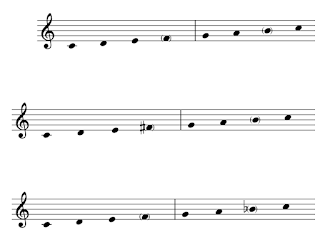Equal temperament- the Chinese invented it, rejected it and readopted it
The study of tuning and temperament is a different task since there was no one single method, and case by case there are various of them on different occasions and instrumentations. The worst case, loss in tradition, also happened in China due to wars and invasions.
The most popular pentatonic system is based on the ratio of 4/3, multiplies the previous result of 2/3, multiplies the previous result 4/3, and so on. (link for the calculation detail.) Using this method we get the pentatonic scale and can be further expanded to 12 keys. At the same time, we still met the Pythegroen comma. Based on the backbone of pentatonic, notes can be added between mi-sol and la-do. (see pic) The added notes are in parentheses to form heptatonic (7-note) scales. Chinese opera and small instrumental ensemble trend to use heptatonic scales.
 |
| 3 common heptatonic scales in the key of C. |
- Vocal music is dominant- the pure P5 is easy for tuning by ears by singers. (Yang, 2015)
- No keyboard instrument like harpsichord, most of the Chinese instruments are agile to tune or a set of instruments with different sizes like Dizi. (Fisher, 1973)(The stone or bronze chime in court music is an exemption. But court music tradition had lost throughout history, I would not discuss today.)
- Tunes prefer changing mode (same note-set but in different tonal center) rather than changing key.
- Hetrophonic texture (when stacking third in Pyth. tuning, the third is noticeable out of tune).
- Small ensemble setting, echoing 2. that everyone can adjust with each other.
- Favor in just intonation sectionally in guqin music, playing harmonics also an important tone color and requires simple ratios in the length of the strings.
However, in the 19th century, the opium war (1839) marked the decay of Chinese culture. Intellectuals studied abroad and hoped to contribute what they had learned back to China, make the country powerful again. One thing particular in music is the symphonic orchestra setting for the west, such a big ensemble had not existed before. In order to put different folk instruments, ET is a handy scheme. The ET was reintroduced back to China.
Yang, Y. et al. (2015) Tuning Features of Chinese Folk Song Singing: A Case Study of Hua’er Music. Journal of voice. [Online] 29 (4), 426–432.


Comments
Post a Comment